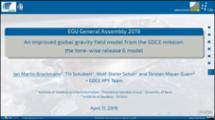Brockmann, Jan Martin; Schubert, Till; Mayer-Guerr, Torsten; Schuh, Wolf-Dieter: An improved global gravity field model from the GOCE mission: the time-wise release 6 model. Wien: European Geosciences Union, 2019.
Online-Ausgabe in bonndoc: https://hdl.handle.net/20.500.11811/1418
Online-Ausgabe in bonndoc: https://hdl.handle.net/20.500.11811/1418
@proceedings{handle:20.500.11811/1418,
author = {{Jan Martin Brockmann} and {Till Schubert} and {Torsten Mayer-Guerr} and {Wolf-Dieter Schuh}},
title = {An improved global gravity field model from the GOCE mission: the time-wise release 6 model},
publisher = {European Geosciences Union},
year = 2019,
note = {The Gravity field and steady-state Ocean Circulation Explorer (GOCE) completed its science mission to observethe Earth’s gravity field in 2013. From the collected observations, gravity gradients and tracking by the GPSconstellation, global gravity field models were estimated in terms of spherical harmonic series. From the completemission data set, the release 5 gravity field models were published in 2014.One of those models is EGM_TIM_RL05 which is computed with the time-wise approach. Within the computationof the time-wise models only GOCE observations are used. They remain independent of other available groundor satellite based gravity data sets. Thus, it represents the gravity field as seen by the GOCE mission. Within theestimation of the time-wise models, a lot of effort is spent on the stochastic modeling of the input observations toderive an uncertainty description in form of a covariance matrix.Recent studies have identified an imperfect calibration of the level 1B gravity gradients. Within a reprocessingcampaign, the entire mission data set was reprocessed, such that the quality of the gravity gradients couldbe significantly improved. In addition, the orbits were reprocessed, reducing systematic artifacts. Within thiscontribution, the sixth release of the time-wise GOCE gravity field models is presented. Using the reprocessedinput data, orbits as well as gravity gradients, and a robustified processing, the entire data set is used to estimatethe updated gravity field model EGM_TIM_RL06. The processing used to generate the new solution is shown.It is validated and compared to the older releases. Three kinds of improvements are shown: i) a reduction of themean error in the range of 15 to 25 %, ii) a reduction of systematic errors at centimeter level and iii) an even morerealistic covariance description. The presented model will be made available as the ESA official GOCE time-wisegravity field model.},
url = {https://hdl.handle.net/20.500.11811/1418}
}
author = {{Jan Martin Brockmann} and {Till Schubert} and {Torsten Mayer-Guerr} and {Wolf-Dieter Schuh}},
title = {An improved global gravity field model from the GOCE mission: the time-wise release 6 model},
publisher = {European Geosciences Union},
year = 2019,
note = {The Gravity field and steady-state Ocean Circulation Explorer (GOCE) completed its science mission to observethe Earth’s gravity field in 2013. From the collected observations, gravity gradients and tracking by the GPSconstellation, global gravity field models were estimated in terms of spherical harmonic series. From the completemission data set, the release 5 gravity field models were published in 2014.One of those models is EGM_TIM_RL05 which is computed with the time-wise approach. Within the computationof the time-wise models only GOCE observations are used. They remain independent of other available groundor satellite based gravity data sets. Thus, it represents the gravity field as seen by the GOCE mission. Within theestimation of the time-wise models, a lot of effort is spent on the stochastic modeling of the input observations toderive an uncertainty description in form of a covariance matrix.Recent studies have identified an imperfect calibration of the level 1B gravity gradients. Within a reprocessingcampaign, the entire mission data set was reprocessed, such that the quality of the gravity gradients couldbe significantly improved. In addition, the orbits were reprocessed, reducing systematic artifacts. Within thiscontribution, the sixth release of the time-wise GOCE gravity field models is presented. Using the reprocessedinput data, orbits as well as gravity gradients, and a robustified processing, the entire data set is used to estimatethe updated gravity field model EGM_TIM_RL06. The processing used to generate the new solution is shown.It is validated and compared to the older releases. Three kinds of improvements are shown: i) a reduction of themean error in the range of 15 to 25 %, ii) a reduction of systematic errors at centimeter level and iii) an even morerealistic covariance description. The presented model will be made available as the ESA official GOCE time-wisegravity field model.},
url = {https://hdl.handle.net/20.500.11811/1418}
}






